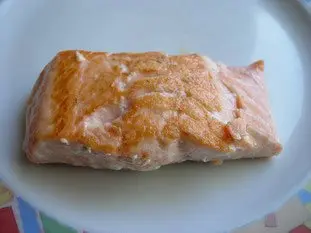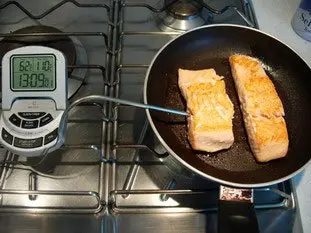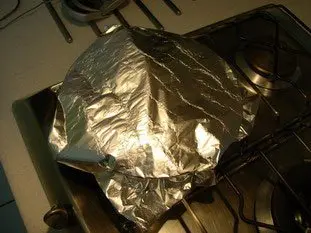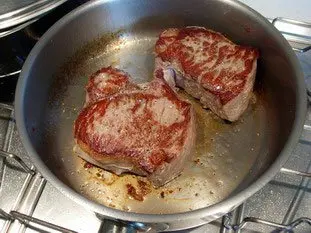This site uses only a few technical cookies necessary for its operation. By continuing to browse, you accept their use.
To find out more...
To find out more...
The secret of cooking until "done"

This is a real chef's skill: being able to look at a fish fillet cooking and say, "Stop – that's enough, it's cooked". I always admire this ability to see at a glance if something is done. It is what sets the professionals apart from us mere amateurs.
And it's true that how fish is cooked is important. If it is underdone, it can be sticky and tasteless, overdone and it dries out and becomes rubbery.
And it's true that how fish is cooked is important. If it is underdone, it can be sticky and tasteless, overdone and it dries out and becomes rubbery.
20 K 4.4/5 (25 reviews)
Keywords for this post:CookingChefJustTimeFishMeatMeasureThermometerLast modified on: November 26th 2012
The secret of cooking until "done"
Here we have a problem: the chef's eye (so they say) is only acquired after many years of experience, so it's unlikely that you or I will ever have it! So are our eyes only good for shedding a regretful tear? No – we can dry our eyes and let technology come to the rescue: for food to be cooked just right is simply a matter of temperature. In other words, fish will be perfectly cooked when the temperature in the centre of the fillet reaches 65-70°C (149-158°F).
Here's the trick: first cook the fish on one side (salted and peppered beforehand). When it looks sufficiently fried or grilled, turn it over and stick an electronic thermometer into the centre.
As soon as the temperature shown reaches 65°C (149°F), remove the fish from the heat, transfer onto a hot plate and cover with aluminium foil. If you leave the thermometer in, you will see that even away from the heat source, the temperature will continue to rise by a few more degrees until it reaches around 70°C (158°F), so the fish will still be cooking.
This resting time also allows the juices which have flowed towards the outside to be reabsorbed into the flesh, giving you the tenderest and tastiest fish ever!
You may well be surprised at just how little time it takes to reach this temperature. You will no doubt find that you tended to overcook fish before.
2 observations:
- Certain electronic thermometers are fitted with an alarm which beeps at the chosen temperature, which is very useful.
- You will no doubt see other temperatures, less than 65°C, stated elsewhere. This is a matter of taste.
Chefs – yes, them again – use touch to judge how cooked red meat is.
This is not easy for the amateur but, fortunately for us, help is at hand! You can use the same method for red meat, but this time the temperature to watch for depends on how well done you like it:
52°C (126°F) = very rare (“bleu” = “blue” in French)
60°C (140°F) = rare
65°C (149°F) = medium
70°C (158°F) = well done
But these temperatures are very approximate, as for red meat, you need to establish your own scale, according to your own taste.
Measure
Here's the trick: first cook the fish on one side (salted and peppered beforehand). When it looks sufficiently fried or grilled, turn it over and stick an electronic thermometer into the centre.

Leave to rest
As soon as the temperature shown reaches 65°C (149°F), remove the fish from the heat, transfer onto a hot plate and cover with aluminium foil. If you leave the thermometer in, you will see that even away from the heat source, the temperature will continue to rise by a few more degrees until it reaches around 70°C (158°F), so the fish will still be cooking.

This resting time also allows the juices which have flowed towards the outside to be reabsorbed into the flesh, giving you the tenderest and tastiest fish ever!
You may well be surprised at just how little time it takes to reach this temperature. You will no doubt find that you tended to overcook fish before.
2 observations:
- Certain electronic thermometers are fitted with an alarm which beeps at the chosen temperature, which is very useful.
- You will no doubt see other temperatures, less than 65°C, stated elsewhere. This is a matter of taste.
What about meat?

Chefs – yes, them again – use touch to judge how cooked red meat is.
This is not easy for the amateur but, fortunately for us, help is at hand! You can use the same method for red meat, but this time the temperature to watch for depends on how well done you like it:
52°C (126°F) = very rare (“bleu” = “blue” in French)
60°C (140°F) = rare
65°C (149°F) = medium
70°C (158°F) = well done
But these temperatures are very approximate, as for red meat, you need to establish your own scale, according to your own taste.
Lasts posts
Butter vs. grease
We often read in a recipe where a pastry is put into a mould that, just before pouring, the mould should be buttered or greased. But what's the difference between these 2 terms?December 1st 20259825
Getting out of the fridge early
Very often when you're cooking, you need to take food or preparations out of the fridge, to use them in the recipe in progress. There's nothing tricky about this: you just take them out of the fridge and use them, usually immediately, in the recipe. But is this really a good method?November 24th 20251,1135
Who's making the croissants?
When you look at a bakery from the outside, you naturally think that in the bakery, the bakers make the bread, and in the laboratory, the pastry chefs make the cakes. It's very often like that, with each of these professions having quite different ways of working, but sometimes there's also one...November 23th 20251,006
Oven height
When we put a dish or cake in the oven, we naturally tend to put it on the middle shelf, and that's what we usually do. But in some cases, this position and height can be a little tricky, so let's find out why.October 8th 20252,7415
The importance of sieving
In recipes that use a fine powder (flour, powdered sugar, etc.), you'll often see the advice to sift before using it. To sift is to pass the powder in question through a sieve (a very fine strainer) before incorporating it into your recipe. It's often advice, but is it really useful?September 3rd 20257,5293
Other pages you may also like
The first breads of humanity?
I have already told you in a previous article the beautiful story of the croissants, but do you know what it is about the bread, who "invented" it, where and when? Well, you can imagine that recent discoveries, in 2018, have profoundly changed the history of bread.February 16th 201914 K5
The 3 kinds of meringue
Meringue – what could be simpler? Just beaten egg whites with sugar added. This makes a fairly stiff mixture which can then be cooked in a cool oven to create those lovely, light confections. But in the world of professional patisserie, meringue comes in three different kinds. Even if the...June 14th 201364 K4.5
Beans in primeur
As I write this, it is the beginning of the short season for fresh beans. If you've never made them before and you're just starting out (and that's a great idea) you'll find that it's a bit time consuming to prepare, you have to shell them once, remove the beans, scald them to remove the skin (and...June 4th 202214 K
Divide and weigh dough into regular pieces
When you prepare dough for cupcakes in a pastry shop or bakery, at some point you're going to have to divide it, i.e. cut it into small pieces, which should all have the same weight. Sounds simple enough, but is it really that simple?May 30th 202312 K5
No need to boil gelatin
Gelatin is a magical ingredient for making light, creamy, structured desserts, yet it's often misused in the kitchen. A common mistake in some recipes is the idea that it needs to be boiled for it to work properly, but this is a mistake indeed: gelatin melts at a much lower temperature, around...November 21th 20248,2745
Post a comment or question
Follow this page
If you are interested in this page, you can "follow" it, by entering your email address here. You will then receive a notification immediately each time the page is modified or a new comment is added. Please note that you will need to confirm this following.
Note: We'll never share your e-mail address with anyone else.
Alternatively: you can subscribe to the mailing list of cooling-ez.com , you will receive a e-mail for each new recipe published on the site.









